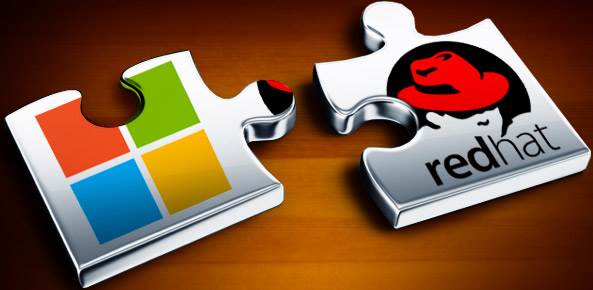The Microsoft-Linux wars are a faint memory this week as Microsoft and Red Hat ink a forward-thinking partnership in the cloud. The alliance aims to help Microsoft Azure customers embrace hybrid cloud computing by offering them more flexibility and choices for deploying Red Hat solutions on the platform.
Some years back, Microsoft was at war with Linux as well as with the free and open source software crusade in general. However, now that Microsoft’s CEO Satya Nadella has shifted his company’s focus away from safeguarding its Windows operating system position and onto the cloud, former competitors are becoming partners.
In a key part of this deal, Microsoft is offering Red Hat Enterprise as the enterprise Linux workload of choice on Azure. But that’s just where the newfound friendship begins. The companies are also partnering to tackle enterprise, ISV (independent software vendor) and developer challenges with solutions that make it easier to build, deploy and manage apps on Red Hat software whether companies are using private or public clouds.
“The datacenter is heterogeneous, and the cloud is hybrid,” said Paul Cormier, president of products and technologies at Red Hat. By joining forces with Microsoft, the companies are uniting “on common solutions to help them solve challenges in this hybrid cloud,” he said. The partners are offering a “comprehensive support agreement for our mixed technologies to support customers,” Cormier added.
What the Deal Looks Like
Drilling down into the particulars of the deal, it makes Red Hat solutions natively available to Azure customers. Microsoft Azure will become an official Red Hat Certified Cloud and Server Provider in the weeks ahead, paving the way for customers to run Red Hat Enterprise Linux apps and workloads on Azure. What’s more, customers with virtual machine images who subscribe to Red Hat Cloud Access can run those images in Azure.
On the other side of the equation, Azure customers can leverage every single advantage the Red Hat app platform has to offer, including Red Hat JBoss Web Server, Red Hat JBoss Enterprise Application Platform, Red Hat Gluster Storage, and OpenShift, which is the company’s platform-as-a-service play.
Going forward, Red Hat and Microsoft have plans to make on demand Red Hat Enterprise Linux images available in the Azure marketplace, supported by Red Hat. Customers can also tap into cross-platform, cross-company customer support. The firms are co-locating support teams in the same building to streamline tech help.
Next, the companies will focus on unified workload management across hybrid cloud deployments. That means Red Hat CloudForms will interoperate with Microsoft Azure and Microsoft System Center Virtual Machine Manager. And that means Red Hat customers can manage Linux on Azure and Hyper-V. Plans call for adding Azure workload management support from CloudForms in the coming months, which essentially extends the current System Center features for Red Hat Enterprise Linux management.
Finally, the firm will collaborate on .NET for the next generation of app development capabilities. As part of this initiative, developers will have access to .NET technologies across Red Hat software. And .NET Core on Linux will point to Red Hat Enterprise Linux as its primary development and reference operating system.
Exploring Coopetition
We caught up with Rob Enderle, principal analyst at the Enderle Group, to get his thoughts on the history and future of the Microsoft-Red Hat partnership. He told us Microsoft stepped aside from the Linux dispute some time ago.
“Remember, a lot of the Linux folks initially were extremely focused on putting Microsoft out of business and Microsoft believed they had stolen from them to do it, so it was kind of personal,” Enderle said. “Over time, those radical elements pretty much burned out of Linux and more and more employees came into Microsoft with open source and Linux backgrounds and eventually the war petered out due to lack of participation.”
Enderle notes another dynamic: the European Union forced Microsoft into going open source and providing open APIs. Initially, of course, Microsoft fought this but later realized that paying $ 1 billion dollar fines wasn’t sustainable.
“Microsoft changed tactics, embraced the rules and found out that the result was even more profitable so they became believers,” Enderle said. “With the animosity out of the way it is more like a normal competition and Microsoft defined the term coopetition.”







